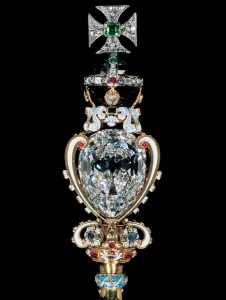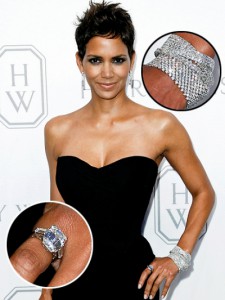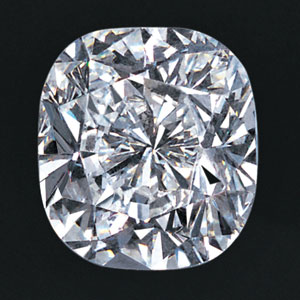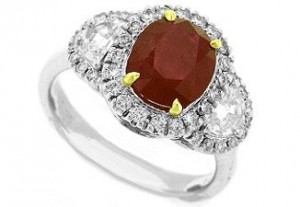All eyes are on Britain with the arrival of the newest British royal. The first child of the Duke and Duchess of Cambridge will be in-line for the throne and to wear – perhaps – some of the most prized royal possessions.
Monthly Archives: July 2013
GIA Report: The British Royal Jewels; Beautiful and Historic Gems
Filed under Uncategorized
The psychology of choice in engagement rings and wedding bands
In NYC Diamond Blog’s coverage of Hollywood, and the opinions of published dating experts nationwide comes this article in today’s Huff Post by Damona Hoffman. It is interesting, amusing, and worth a quick look.
Halle Berry has tied the knot again. We’re hoping that the third time is a charm for this soon-to-be mom of two. Will her marriage to Olivier Martinez be able to stand the test of time? Since my crystal ball is in the shop, I thought I’d investigate some other predictors of relationship success. Did you know that your wedding ring can actually indicate the kind of relationship you have?
I asked Simon Katz from a large jewelry website, who actually studied psychology and sociology before getting into the jewelry business, to help me analyze Halle’s engagement ring to see what her choice of ring says about their relationship future.
“Halle has had troubled relationships in her past. By choosing an actual Emerald in an Emerald Cut, she’s basically declaring, ‘I’m not going to go down the same path I’ve already been. I’ve learned my lessons, and I’m carving out a new road,'” Katz told me. “A three-stone ring setting is definitely glamorous and allows the wearer to let her unique personality shine through with different combinations of diamonds and gemstones.”
I remember the months leading up to my own engagement vividly. I was so eager to finally get that stone after three years of dating that I didn’t care what it looked like. Now that I’m aware of the various meanings behind the setting, cut, and shape, I am encouraging my successful dating coaching clients to be a little more discerning.
Katz says, “The selection of an engagement ring should be a thoughtful process so it ends up matching the personality of the wearer. The kind of engagement ring one finally chooses can also tell a lot about the present and future relationship.”
So what does your choice of ring really say about you?
The Cut And Shape Of The Stone
Classic round: The future bride and groom are likely to be traditional, perhaps a bit conservative, faithful to each other, and very loyal.
Emerald cut: More often than not, money is no object when it comes to showering each other with affection.
Princess cut: The bride-to-be will most likely be a pampered spouse, with the future groom being a dedicated, thoughtful husband.
Pear shaped: The engaged couple can be quite independent and have high standards, but ultimately supportive of each other.
Marquise cut: The engagement and marriage are punctuated with chic and glamorous events, calling for many opportunities to play dress-up.
Heart shaped: The future bride and groom are not afraid to indulge in public displays of affection now and then. They are also most likely to be giddy at their own wedding!
Oval shaped: Stability and serenity are important to the couple who choose this shape.
The Shape and Design of the Band
Traditional band: With no discernible ending and beginning, a perfectly round engagement ring tells of a future life together which the couple cannot wait to begin right away.
Split shank: This style splits the band in half near the center diamond, indicating that despite having different personalities, the people in the relationship are always one in heart, mind, and spirit.
Solitaire: As classic as they come, the solitaire speaks of a simple life together with basic values holding up the relationship as time goes by.
Three-stone setting: Symbolizing the couple’s past, present, and future, this setting serves as a precious timeline of a relationship.
Stackable rings: Flush-style engagement rings and wedding bands fit harmoniously so they form one smooth, streamlined shape when worn together. This indicates that the engaged couple is thoughtful, are careful planners, and are forward-thinking.
Engraved band: A sentimental and unique couple with plenty of private jokes and shared interests will likely choose an engagement ring engraved with symbols that mean something special to the two of them.
Just like relationships, each ring has it’s own unique identity so when you walk down the aisle, make sure you pick a ring that mirrors the love you feel for one another.
Filed under Uncategorized
Sparkling: Diamonds could be Investor’s Best Friend
NYC Diamond Blog’s mission is to inform readers of all facets of the Diamond industry, including developments, and expert opinions from around the world. Here is an article from the UK written by Julian Knight and Chiara Cavaglieri. It appeared in ‘The Independent’ newspaper over the weekend.
For centuries diamonds have been a symbol of wealth coveted by brides-to-be and collectors, but could these most precious of stones also prove the ordinary investor’s best friend?
Gold has traditional been the preferred commodity for many investors, but now that it is down from its peak, diamonds are an attractive prospect if you’re looking for an alternative. In the last five years, one to five-carat diamonds provided annual returns of 12 per cent and this year, global diamond prices are predicted to increase by around 10 per cent, while the
price of the best gems could jump as much as 50 per cent, according to gem trading company Diamond Manufacturers. However, such claims coming from firms involved in the trade should be taken with a pinch of salt.
Prices have been driven up by demand from the emerging middle classes in India and China, the lack of major mining discoveries and, when it comes to the price of cut diamonds, the market is still tightly controlled by the likes of De Beers who have diamonds in store.
If you have a magpie’s weakness for shiny things, there are three ways to invest in diamonds: you can buy the gems and store them to sell at a later date; you can buy shares in diamond-mining companies; or you can gain exposure via diamond funds.
Holding the physical asset means you can set the diamonds into jewellery and make the most of its aesthetic quality until you’re ready to sell. Buy your gems through a reputable diamond trader rather than a jeweller who will add a retail mark-up of as much as 300 per cent compared to prices on the wholesale market. Vashi Dominguez, chief executive of Diamond Manufacturers, advises spending £5,000 on a quality stone and be prepared hold on to it for at least five years.
“Each diamond should have come with a certificate from a laboratory which confirms its grade – the GIA is the best known and one of the most-respected labs, the Dutch equivalent, HRD, also gets mentioned. Other certificates will be less trusted when reselling,” says Adam Laird, investment manager at independent financial advice firm Hargreaves Lansdown.
The most-important issue for investors is that the diamond trade is an unregulated market blighted by a lack of transparency. There is an index – the Rapaport Diamond Trade Index – but this only serves as a guideline as the vast majority of diamonds don’t actually trade at these prices. The “four C’s” help to determine the value of any given diamond -the cut, color, clarity and carat weight – but every diamond is unique, like a snowflake or a fingerprint,which means they must be valued individually
Filed under Uncategorized
Ruby, the July Birthstone
The birthstone for July is Ruby,the red variety of the mineral Corundum, the second hardest natural mineral known to mankind. Ruby has been associated with the values of love, success, integrity, passion, and promise. The finest ruby color is vivid, almost pure spectral red as seen in the highest quality Burmese rubies, which are considered the finest. Ruby is also the anniversary gemstone for the 15th and 40th year of marriage. Ancient lore states that the highest quality rubies were said to protect their owners from all kinds of misfortune. There are many who believe a ruby that has not been internally faceted, when worn in jewelry touching the skin will help keep a pregnant women’s unborn baby safe and healthy. NYC Wholesale Diamonds and our Fine Jewelry division stock a complete selection of Ruby and Diamond Rings, Necklaces, Earrings and Tennis Bracelets.
Filed under Uncategorized
Everything You Ever Wanted To Know About Engagement Ring Insurance
.
This is important, as you want the freedom to return to a jeweler you trust, or at least have the option to shop around. A jeweler with the best interests of the insurance company does not have your best interests as their priority.
.
Filed under Uncategorized





